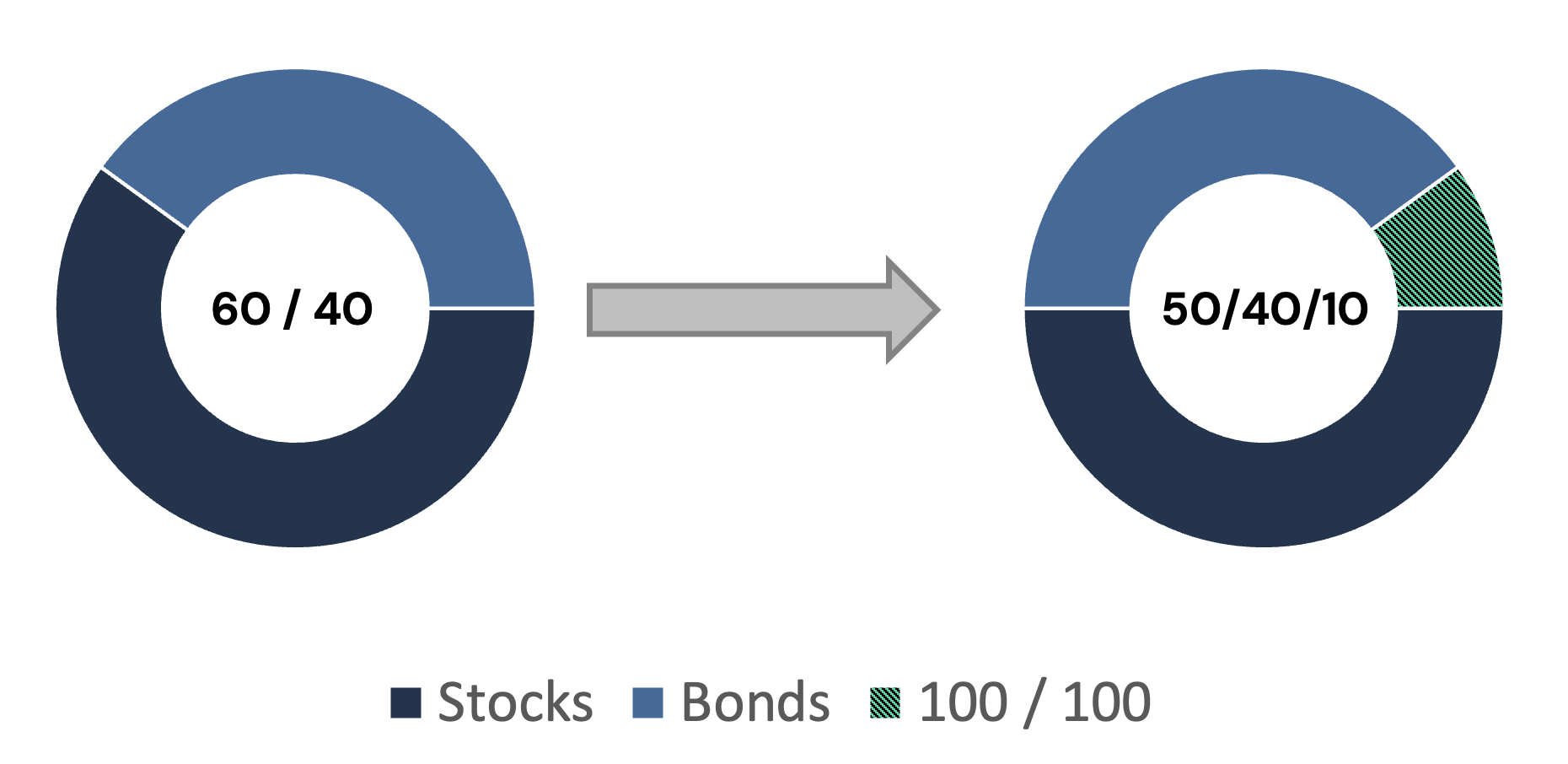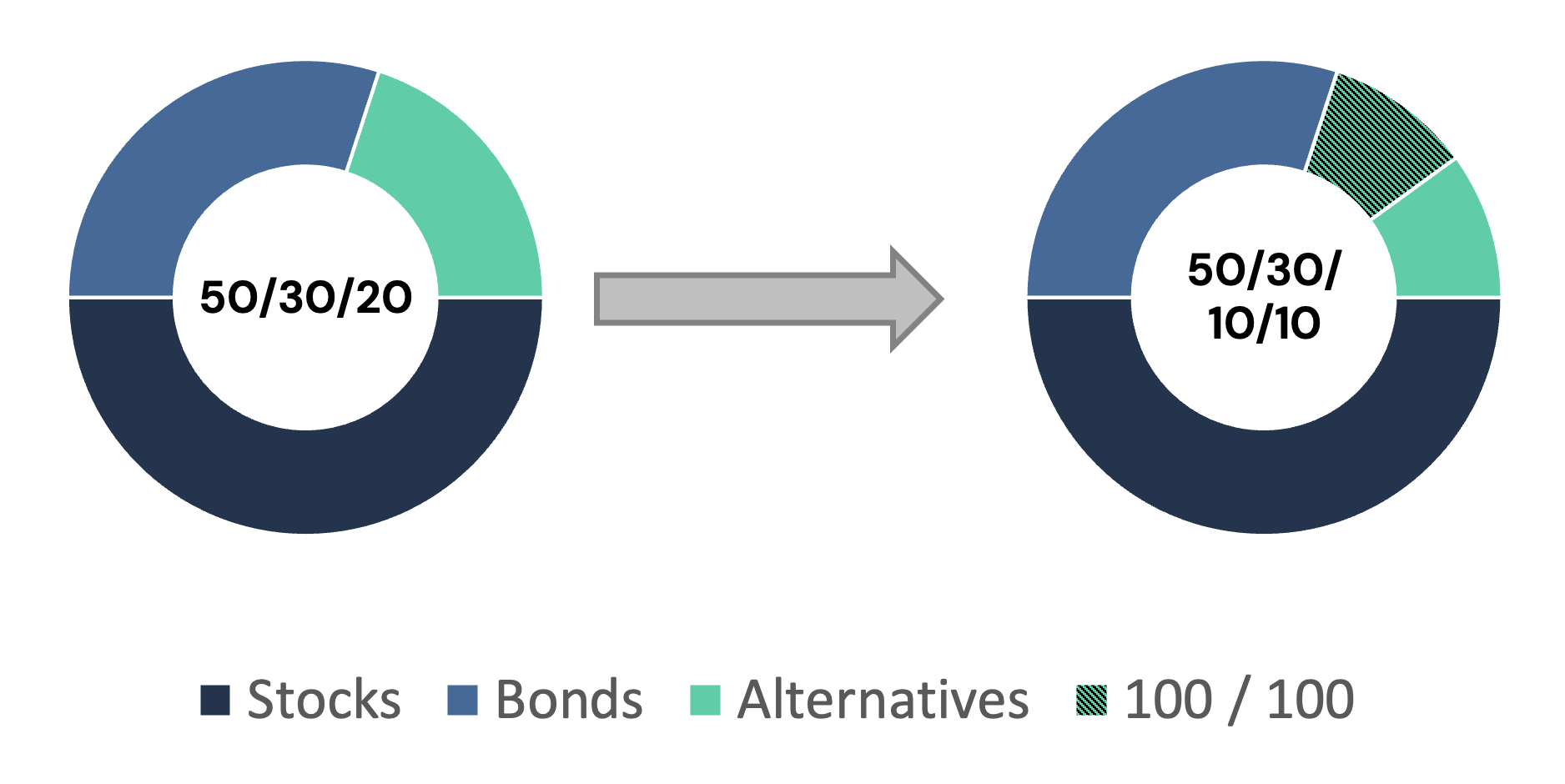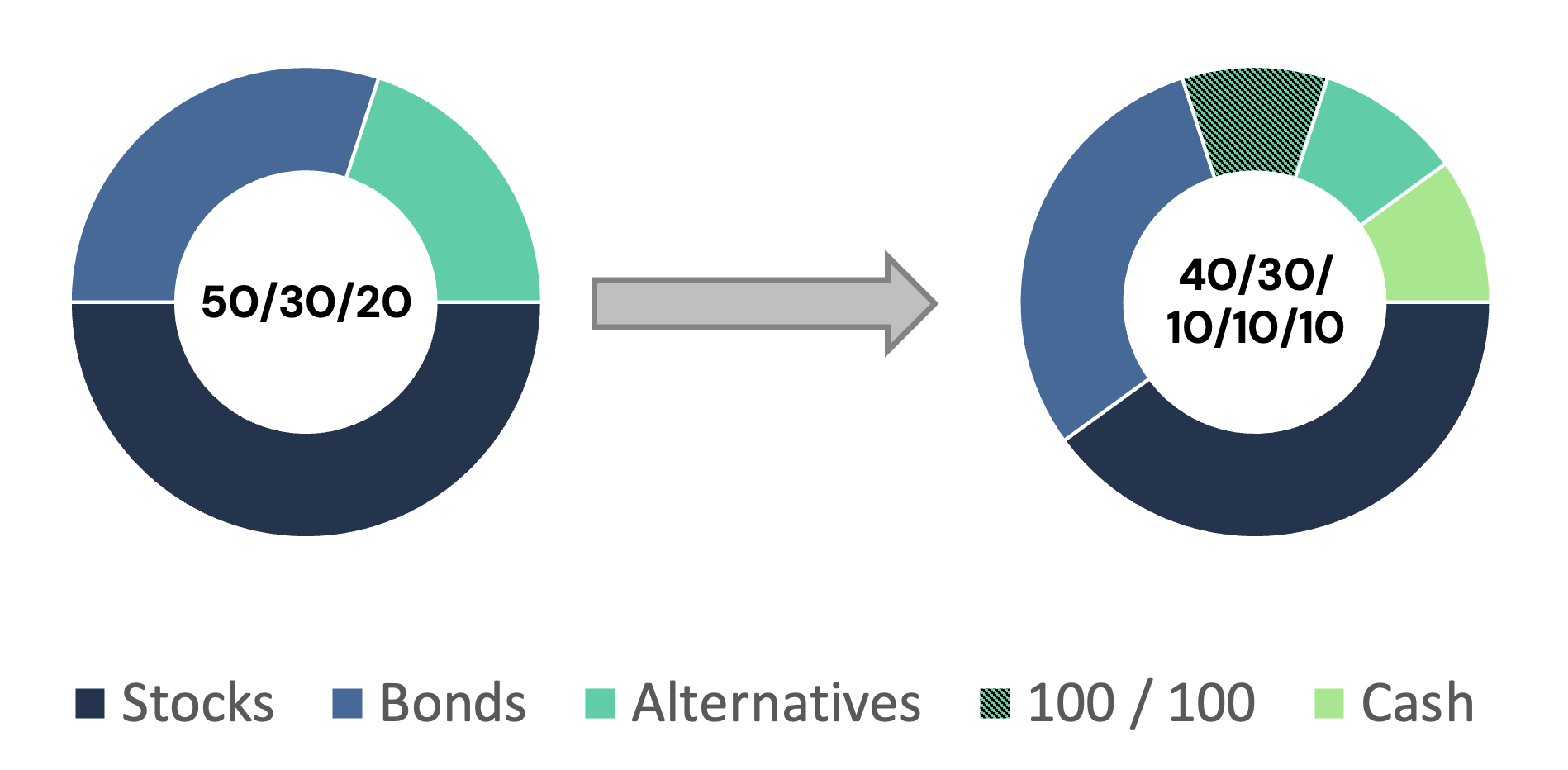Diversification Without Compromise: Three Ways to Use Return Stacking in a Portfolio
Overview
Return stacking, also known as portable alpha, is a portfolio strategy that allows advisors to maintain core investment exposure while adding diversifying return streams – without necessarily requiring painful trade-offs. This article explores three practical ways to implement a return stacking solution: (1) introducing alternatives without sacrificing equities, (2) reintroducing equity beta to an alternative-heavy portfolio, and (3) reducing line-item risk to improve client retention. By leveraging return stacking, advisors can seek to enhance diversification and improve portfolio resilience while keeping clients engaged through full market cycles.
Key Topics
Portfolio Construction, Line-Item Risk
Introduction
Return stacking is a powerful portfolio construction technique that allows investors to maintain core portfolio exposures while layering in additional diversifying return streams. For financial advisors, it presents a potentially compelling way to enhance portfolios without forcing painful trade-offs. But how should advisors think about integrating return stacking into client portfolios?
To explore this, we consider a specific example: a return stacked solution that combines 100% U.S. equities with 100% managed futures. This structure seeks to maintain full equity exposure while simultaneously adding managed futures, a historically uncorrelated return stream that has potential to enhance returns and improve risk-adjusted performance. With that framework in mind, let’s walk through three common ways advisors can use return stacking in client portfolios.
1. Adding Managed Futures Without Changing the Core Portfolio
Many advisors recognize the benefits of managed futures but hesitate to allocate to them because it often requires reducing core investment exposure. This can be a tough sell to clients who are accustomed to a traditional 60/40 portfolio or who fear missing out on stock market growth. Return stacking allows advisors to introduce managed futures without reducing stock or bond allocations. Instead of carving out a portion of equities or bonds, an advisor can replace a percentage of equities with a return-stacked solution that provides 100% equity exposure + 100% managed futures exposure in a single position.
For example, an advisor wanting to add a 10% allocation to managed futures while maintaining a 60/40 equity/bond split could sell 10% of equities and purchase a 100/100 equity/managed futures fund. This approach ensures the portfolio maintains full equity exposure while layering in managed futures. By maintaining equity exposure and introducing managed futures, this approach seeks to enhance diversification and improve risk-adjusted returns. Clients may be more comfortable knowing their stock allocation remains intact, reducing behavioral resistance to holding managed futures. Additionally, integrating managed futures may provide an uncorrelated return stream, which can potentially improve overall portfolio resilience.
Figure 1: Adding a Managed Futures Overlay
Source: Newfound Research. For Illustrative Purposes Only.
Beyond theoretical portfolio improvements, one of the key potential advantages here is behavioral. Many investors hesitate to reduce their stock allocation, even when they understand the benefits of diversification. With return stacking, advisors can sidestep this objection by maintaining equity exposure while still incorporating an alternative strategy. This approach seeks to enhance return potential without requiring a fundamental shift in the client’s portfolio philosophy.
Register for our Advisor Center
Tools Center:
Easily backtest & explore different return stacking concepts
Model Portfolios:
Return stacked allocations, commentary and guidance designed
for a range of client risk profiles and goals
Future Thinking:
Receive up-to-date insights into the world of return stacking theory and practice
2. Restoring Traditional Stock/Bond Exposure After Adding Managed Futures
Some advisors have already introduced managed futures into client portfolios but, in doing so, have reduced core equity and bond exposure. For example, a portfolio that was originally 60/40 might now be 50/30/20 (stocks/bonds/managed futures) after carving out a portion of stocks and bonds. Return stacking provides a way to restore equity exposure while keeping managed futures in place.
An advisor managing a 50/30/20 portfolio may want to reintroduce equity beta while maintaining managed futures. To do this, they could sell 10% of their managed futures and use the proceeds to purchase 10% of a 100/100 equity/managed futures fund. The result is a portfolio that keeps its managed futures allocation intact while restoring the traditional 60% stock exposure.
Figure 2: Restoring Traditional Stock/Bond Exposure
Source: Newfound Research. For illustrative Purposes Only.
This can be particularly useful in conversations with clients who have grown concerned about underperformance relative to traditional stock/bond benchmarks. By using a return stacked approach, advisors can offer an alternative strategy that remains diversified while seeking to participate more fully in equity market upside.
3. Reducing Line-Item Risk to Improve Client Retention
One of the biggest behavioral challenges in portfolio management is the phenomenon of line-item bias. Investors often fixate on the individual components of their portfolio, assessing each one in isolation rather than considering how they work together. This can be especially problematic for alternative strategies, which may experience extended periods of underperformance relative to stocks and bonds.
Even when alternatives improve overall portfolio resilience, clients may grow frustrated with them if they focus on short-term performance. Advisors frequently face pressure to reduce or remove these allocations simply because they appear to be “underperforming,” even if they are playing their intended role.
Return stacking can potentially help solve this problem by consolidating exposures into a single fund, making the overall portfolio easier for clients to digest. Instead of holding separate allocations to stocks and managed futures, an advisor could shift a portion of each into a return stacked solution. For instance, if an advisor holds a 50% equity / 30% bond / 20% managed futures portfolio, they could sell 10% of their equity exposure and 10% of their managed futures, allocate 10% into a return stacked fund and hold the remaining 10% in cash. The portfolio’s underlying strategic allocation remains unchanged, but the alternative exposure is “buried” within the equity position.
Figure 3: Reducing Line-Item Risk
Source: Newfound Research. For illustrative Purposes Only.
This slight structural change has the potential to make a significant difference in client behavior as clients are less likely to fixate on the performance of alternatives in isolation. Instead, they see a more streamlined portfolio, which may help reduce emotional reactions and improve long-term investment discipline.
Finding the Right Fit for Each Client
Each of these approaches demonstrates how return stacking can be used to address different advisor challenges. Whether it’s adding alternatives without reducing equities, restoring beta to an alternative-heavy portfolio, or simplifying the client experience, return stacking provides flexibility in portfolio construction.
The right approach depends on an advisor’s investment philosophy, client risk tolerance, and behavioral considerations. But in all cases, the goal remains the same: to build more resilient, diversified portfolios that seek to improve long-term outcomes while keeping clients invested through full market cycles.
As advisors continue to navigate the evolving investment landscape, return stacking represents an innovative tool that expands portfolio possibilities without requiring difficult trade-offs. And in an environment where client behavior is just as important as portfolio construction, that’s an opportunity worth exploring.
Key Takeaways for Financial Advisors
- Maintain Allocation While Adding Alternatives: If you want to introduce managed futures without changing a 60/40 portfolio, consider replacing a portion of stocks with a solution that stacks both equities and managed futures.
- Restore Traditional Stock/Bond Exposure: If your portfolio has drifted from a 60/40 structure due to managed futures, return stacking can help restore the portfolio exposures while keeping managed futures in place.
- Reduce Line-Item Risk and Improve Client Experience: Embedding managed futures within a return-stacked product can reduce client resistance and enhance portfolio behavioral sustainability.
- Enhance Portfolio Diversification: Return stacking enables advisors to add uncorrelated return streams while maintaining core allocations, potentially improving risk-adjusted returns.
- Support Behavioral Resilience: By structuring portfolios to minimize psychological resistance to non-traditional investments, advisors can help clients stay committed to their investment plan over the long term.



